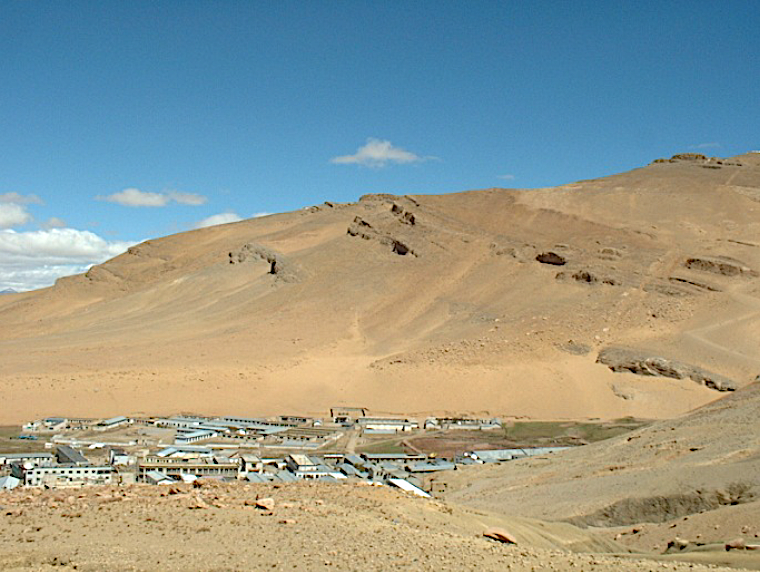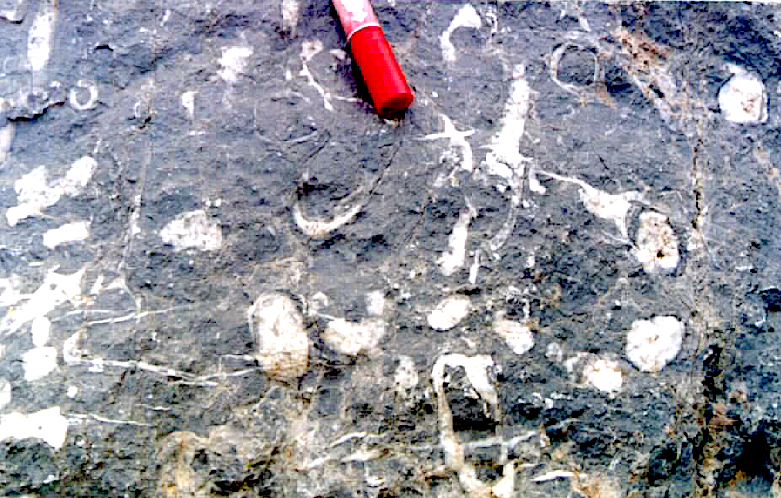Zongshan Fm
Type Locality and Naming
Himalayan South Belt. The Zongshan Formation was erected by Mu Enzhi et al in 1973. The type locality for the designation is at Zongshan 250 m southeast of the Gamba County of Xizang.
Synonym: Zangsain Fm (?)
[Figure: The type section of Zongshan Formation in Gamba County of Xizang (Tibet)]]
[Figure: Upper member of Zongshan Formation behind Gamba County of Xizang (Tibet)]
Lithology and Thickness
The Zongshan Formation is subdivided into two members. The Campanian Lower Member consists of a lower unit of gray thick-bedded micritic limestones, and an upper unit of calcareous shales and marls. The Lower Member is 150~176 m thick. The Maastrichtian Upper Member is composed of two layers of thick-bedded packstone intercalated with marls and calcareous shale. The Upper Member is 100~122 m in thickness.
[Figure: Bivalves in Upper member of Zongshan Formation in Gamba]
[Figure: Cretaceous-Paleogene boundary in Gamba Zongshan section, Gamba]
Relationships and Distribution
Lower contact
It overlies conformably on the Gambacunkou Fm
Upper contact
Regional extent
The present formation is mainly distributed in Gamba, Yadong and Tingri counties of Xizang (Tibet).
GeoJSON
Fossils
Foraminifera are the representative fauna in this formation. The Lower Member contains abundant planktonic foraminifera like Globotruncanita elevata, G. stuarti, Contusutruncana fornicata, Globotruncana aegyptiaca, G. arca, G. bulloides, G. ventricosa, G. linneiana, benthic foraminifera Goupillaudinal ecointrei; and Campanian ammonites Menabites pauciturculatus, M. (Delawarella) subdelawarensis, Pachydiscus bassae and Pseudoschloenbachia sp. The Upper Member dominated by packstone yields abundant larger foraminifera fossils, such as Orbitoides media d'Archiae, O. apiculata Schlumberger, Omphalocyclus macroporus (Lamarck), bivalves Biradiolites sp., Bournonia tibetica Douville; and Maastrichtian algae Trinocladus radoicicae Elliott, Cymopolia tibetica and C. eochoristosporica.
The fossils are well preserved in the strata and are dominated by planktonic taxa. Thirteen planktonic foraminifer zones and one larger foraminifer assemblages have been recognized from the south Tibetan Himalaya sedimentary sub-belt. They are Albian Ticinella roberti Zone; Cenomanian Rotalipora brotzeni, R. reicheli and R. cushmani Zones; Cenomanian/Turonian Whiteinella archaeocretacea Zone; Turonian Helvetoglobotruncana helvetica and Marginotruncana sigali Zones; Coniacian Dicarinella primitiva Zone; Coniacian/Santonian Dicarinella concavata Zone; Santonian Dicarinella asymetrica Zone; Campanian Globotruncanita elevata, Globotruncana ventricosa, Globotruncanita stuartiformis Zones and Maastrichtian Orbitoides-Ompaloceclus Assemblage.
Age
Depositional setting
Additional Information



